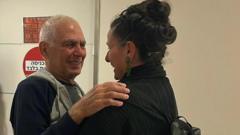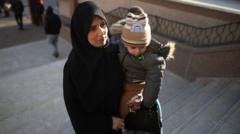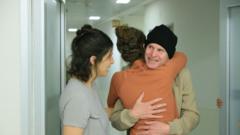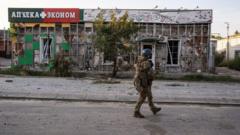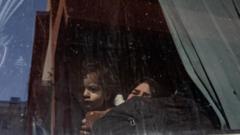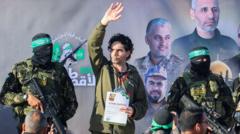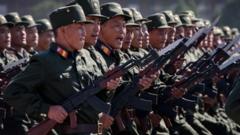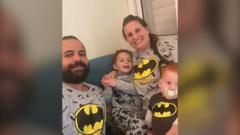Following the recent ceasefire, Gaza’s citizens are faced with the dual challenge of rebuilding their shattered lives and coping with profound trauma. Amid the chaos, individuals like Hatem Al-Atar exhibit extraordinary courage, while tragic stories of young survivors highlight an urgent need for healing and hope.
Resilience Amid Ruins: The Journey of Gaza's Heroes
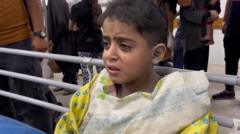
Resilience Amid Ruins: The Journey of Gaza's Heroes
In the aftermath of devastation, Gaza's survivors navigate the path to recovery, carrying the weight of dreams and loss.
In the heart of Gaza, where destruction and despair have become a part of everyday life, stories of resilience and determination emerge from the ruins. Since the war intensified on October 7, 25-year-old Hatem Al-Atar has dedicated his life to civil defense, a role forged by immense bravery against the backdrop of death and destruction. The noise of explosions and the sight of familiar homes reduced to rubble haunt him daily. Despite the peril he faces—having survived a near-fatal strike when a reconnaissance missile hit a building he entered for a rescue—Hatem’s commitment to help his community only deepens.
Tragedy struck for Hatem last March during the arrival of Ramadan, when he received a devastating call informing him of his father’s death during an airstrike. Finding his father in the mortuary alongside eight other victims—his sister-in-law and her children—left him in shock, yet he continues to confront the dangers of his job, dredging through the ruins for both the living and the dead.
With the recent ceasefire, Hatem allows himself to contemplate what the future holds. He expresses aspirations of pursuing his university studies and possibly finding love, a stark contrast to the chaos that has defined recent months. As Gazans attempt to reclaim their lives, they navigate a landscape filled with both fear and hope.
Prof. Jumaa Abu Shiha returned to the wreckage of his family home, overwhelmed by grief and disbelief. He reflects on the painstaking effort he put into building a life with his family only to find it reduced to destruction. Aid continues to flow into Gaza, yet as organizations provide tangible support, they encounter an unseen toll: the psychological scars left on the region's children. Surveys conducted by charities reveal alarming levels of trauma among the youth, with many fearing for their lives and mourning loved ones lost to the violence.
Among these tragic narratives is ten-year-old Amr al Hindi, the sole survivor of an Israeli strike that obliterated his family. Living with his grandparents, Amr now carries the weight of his brother's ambition to study medicine, expressing a desire to fulfill that dream. His poignant recollections, mixed with sorrow and aspiration, epitomize the dual nature of existence in Gaza: a fragile hope layered over deep-rooted anguish.
As life resumes in the shadows of devastation, the road to recovery for Gaza’s people involves not only rebuilding their homes but also healing their minds and hearts. Through their unwavering strength, they embody the resilient spirit of a community determined to rise from the ashes of despair. The complexity of their struggles speaks volumes about the ongoing conflict, transcending mere survival as they seek to rebuild their dreams amidst the remnants of their shattered reality.
Tragedy struck for Hatem last March during the arrival of Ramadan, when he received a devastating call informing him of his father’s death during an airstrike. Finding his father in the mortuary alongside eight other victims—his sister-in-law and her children—left him in shock, yet he continues to confront the dangers of his job, dredging through the ruins for both the living and the dead.
With the recent ceasefire, Hatem allows himself to contemplate what the future holds. He expresses aspirations of pursuing his university studies and possibly finding love, a stark contrast to the chaos that has defined recent months. As Gazans attempt to reclaim their lives, they navigate a landscape filled with both fear and hope.
Prof. Jumaa Abu Shiha returned to the wreckage of his family home, overwhelmed by grief and disbelief. He reflects on the painstaking effort he put into building a life with his family only to find it reduced to destruction. Aid continues to flow into Gaza, yet as organizations provide tangible support, they encounter an unseen toll: the psychological scars left on the region's children. Surveys conducted by charities reveal alarming levels of trauma among the youth, with many fearing for their lives and mourning loved ones lost to the violence.
Among these tragic narratives is ten-year-old Amr al Hindi, the sole survivor of an Israeli strike that obliterated his family. Living with his grandparents, Amr now carries the weight of his brother's ambition to study medicine, expressing a desire to fulfill that dream. His poignant recollections, mixed with sorrow and aspiration, epitomize the dual nature of existence in Gaza: a fragile hope layered over deep-rooted anguish.
As life resumes in the shadows of devastation, the road to recovery for Gaza’s people involves not only rebuilding their homes but also healing their minds and hearts. Through their unwavering strength, they embody the resilient spirit of a community determined to rise from the ashes of despair. The complexity of their struggles speaks volumes about the ongoing conflict, transcending mere survival as they seek to rebuild their dreams amidst the remnants of their shattered reality.

